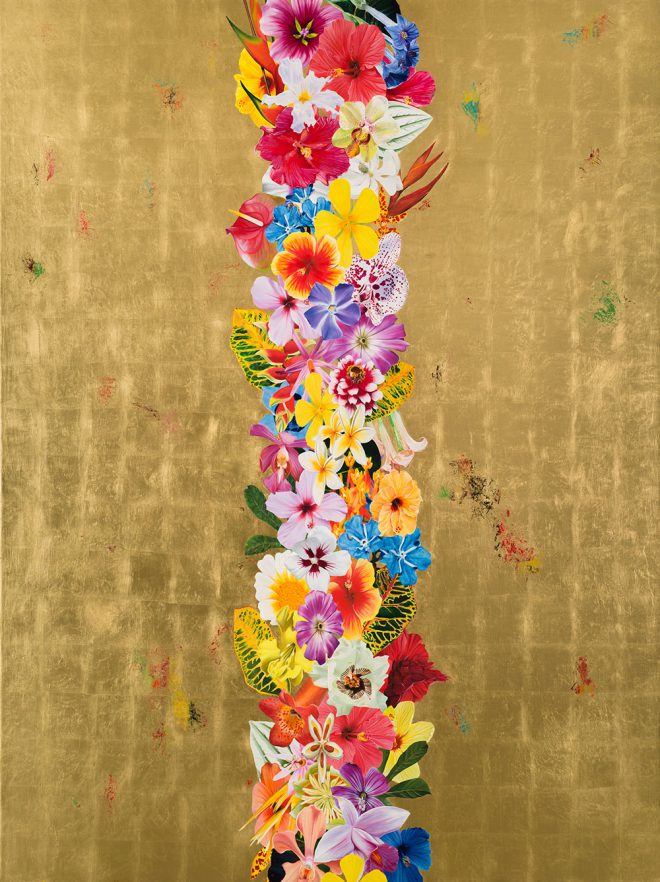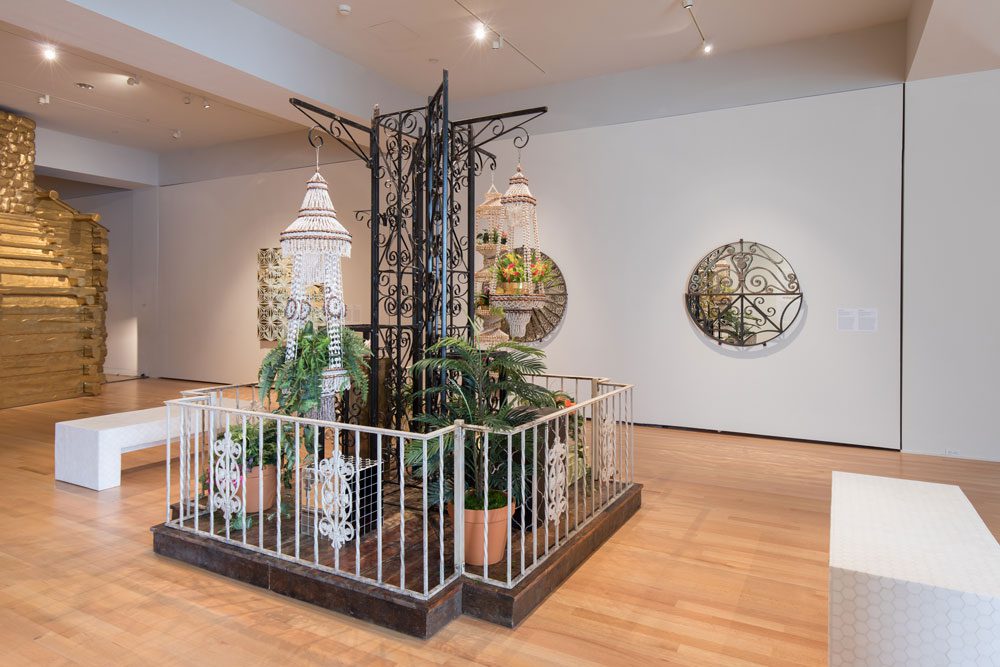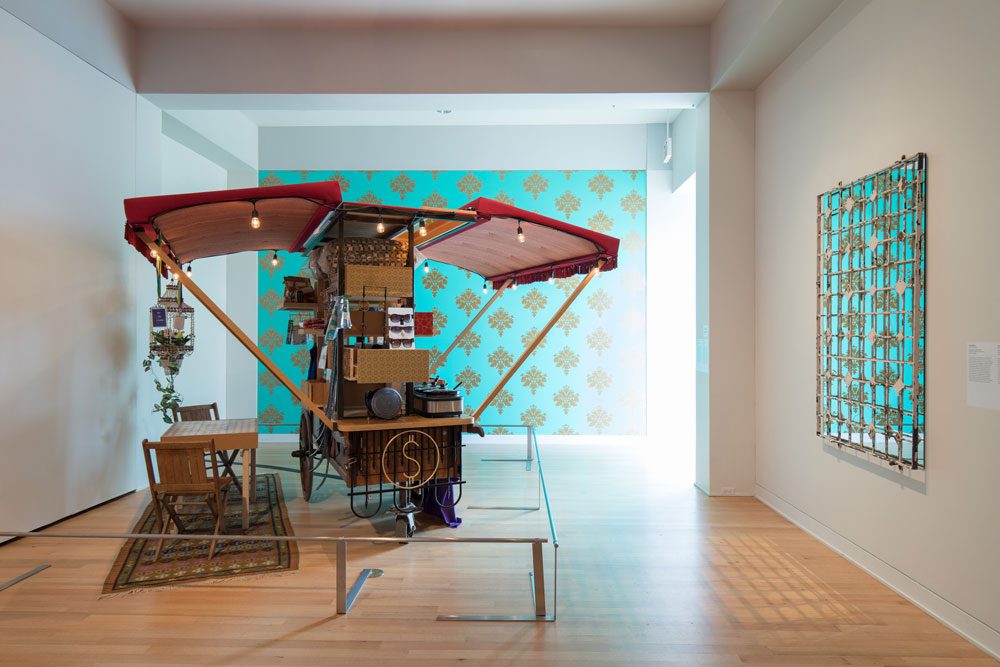Falling Flat: Carlos Rolón at the New Orleans Museum of Art
Charlie Tatum considers whether Carlos Rolón’s artworks, currently on view at the New Orleans Museum of Art, effectively challenge or change the museum’s ways of working.

Carlos Rolón, Gild the Lily (Decadence Upon Decadence I), 2016. Oil, acrylic, satin varnish, and artificial gold leaf on canvas. Courtesy the artist and Library Street Collective, Detroit. Photo by Nathan Keay.
At first glance, it appears that the New Orleans Museum of Art has been revamping its entryway. Four large rectangular planters, adorned with ceramic tiles, mirrors, and geometric ironwork, sit in the museum’s Great Hall, displaying lush tropical foliage. The new interior landscaping is not merely decorative, but part of a current hit-or-miss solo exhibition by Carlos Rolón. The artist’s work takes his upbringing in a Puerto Rican family in Chicago as a starting point to question the ways in which museums have championed and reinforced a canon of artwork by white Europeans and Americans that excludes the voices of working-class communities and people of color. With “Outside/In,” Rolón attempts to interrogate, with varying degrees of success, NOMA’s own connection with its surrounding communities.
“Outside/In” feels like it should be a great step forward for NOMA’s exhibition programming in contemporary art. It’s exciting to see the museum organize a mid-career retrospective of a nationally exhibited artist who is still not a household name—taking a risk instead of relying on cookie-cutter traveling themed shows or presentations of long-time local favorites. Additionally, its subjects of identity and otherness are of personal interest to me and of great importance, especially now, as public conversation in the country has turned again toward debates over immigration, bigotry, and belonging. Walking through the exhibition, however, I found myself drawn to many of Rolón’s ideas but disappointed by the art itself.
Many of Rolón’s works at NOMA reference Puerto Rico’s distinctive rejas, decorative iron gates surrounding homes, much like New Orleans’ own iconic ironwork. Similar to the French Quarter’s “cornstalk fence” and elaborate entryways in the Garden District, Puerto Rican rejas historically served as markers of status and to keep unwanted visitors out. For the sculptures in “Outside/In,” Rolón has affixed salvaged gates from New Orleans and locations in Puerto Rico on top of mirrors, providing, as the artist suggests, a way to see oneself on the inside and outside of these architectural barriers.

Installation view of Carlos Rolón’s “Outside/In” at the New Orleans Museum of Art. Courtesy the artist. Photo by Roman Alokhin.
While the exhibition’s wall text hints at the visual links between former Spanish colonies and the ways in which these imperialist markers have been reclaimed as a source of pride for New Orleanians and Puerto Ricans, the works themselves are too neat for their own complex histories. Sculptures like Untitled (Hybrid Wrought Iron Reja I), 2018, look like something one might buy from HomeGoods to hang over the couch. Even when the works are more visually compelling—like in a related, extremely Instagrammable series on view, in which intricately cut mirrored mosaics mimic the iron patterns and reflect the viewer’s image—they don’t quite envelop. I couldn’t help but contrast them with the work of fellow Chicagoan Edra Soto, who has smartly added reja designs to galleries and museums by applying cut vinyl to windows or installing metal or wooden grating across the entryways. With her GRAFT series, 2013–ongoing, Soto directly associates art spaces with exclusivity and isolation in a way that makes the viewer experience the reinforcement of or transgression across boundaries.
More engaging is Rolón’s Bochinche, 2016, a sculptural hodgepodge of wrought iron fences, porcelain tiles, shell-decorated macramé, and fake plants. Here, Rolón’s use of assemblage parallels the intricate movements of images and traditions across the world through colonialism—with the ornate tilework of Middle Eastern Islamic architecture migrating to North Africa and Spain, and then Spanish design being adapted across the Americas. (Macramé, which Rolón associates with Puerto Rican households and his own family, also has its roots in North Africa and the Middle East.) Bochinche additionally succeeds in its humor: The title comes from a Spanish-language term for gossip, and Rolón’s sculpture contains two marble benches, placed opposite each other so their occupants’ views are obstructed by the installation itself. Though the installation appears to be a space for socialization, Bochinche literally fences viewers out, a joke played on anyone wanting to use the space for a private chitchat.
In promotional materials, NOMA has placed much attention on Rolón’s Nomadic Habitat (Hustleman), 2015, a project originally commissioned for the Chicago Architecture Biennial. Created in collaboration with Garland Gantt, a South Side street vendor, the Hustleman cart mimics mobile, pop-up enterprises selling household goods and bootleg DVDs found not just in Chicago but in urban centers around the world. Though the rotating selection of items in the cart at NOMA is only available for purchase or by barter during special events, Hustleman raises questions about commerce, regulation, and class by inserting street life into the museum—art being its own unregulated sector of the economy.

Installation view of Carlos Rolón’s “Outside/In” at the New Orleans Museum of Art. Courtesy the artist. Photo by Roman Alokhin.
To activate the piece, the museum asked a number of advocacy organizations, like Our Voice Nuestra Voz and Puentes New Orleans, and art groups, including Good Children Gallery and The Front, to create their own temporary shops, bringing some liveliness into the exhibition. For example, artists Marta Rodriguez Maleck and Kevin Brisco Jr. cleverly asked visitors to write down an apology, to anyone about anything, and in exchange to take away someone else’s left-behind note. Like Bochinche or the Great Hall planters, the Hustleman cart shows that Rolón’s artwork is at its best when it makes museumgoers aware of the institution around them.
“Outside/In” is rounded out by a room of pretty, if bland, paintings of flowers, featuring tropical species from New Orleans and across Latin America surrounded by shimmering gold leaf. These works, like much of the exhibition, feel lifeless despite their elements—the richly colored flowers and luxurious gold rendered flat. Although “Outside/In” has brought Rolón’s particular perspective on Puerto Rican culture to the museum and it is notably one of only a few shows there that have included bilingual wall text, it ultimately doesn’t feel like much has changed or that much of the “outside” has actually been let in.
Ironically, Rolón’s exhibition stands as a foil to another museum initiative—the newly launched NOMA+ mobile “pop-up museum,” which aims to bring the inside out. A product of the museum’s education department, the trailer unfolds to create a portable classroom with the goal of introducing NOMA to communities across the city through workshops and youth programs and to make the museum, and museums generally, more approachable. NOMA+ highlights the important, but often hard to pinpoint, distinction between social practice art—which frames viewers’ transformative experiences and the idea of social change as works of art—and actual sustained community engagement, which relies on institutional relationship-building and longevity. While the roving trailer is just beginning to roll, and its success can’t be measured yet, NOMA+ hopefully will allow for greater impact, and even change the way the museum thinks of itself.
Editor's Note
Carlos Rolón’s “Outside/In” is on view through August 26, 2018, at the New Orleans Museum of Art (1 Collins C. Diboll Circle).



